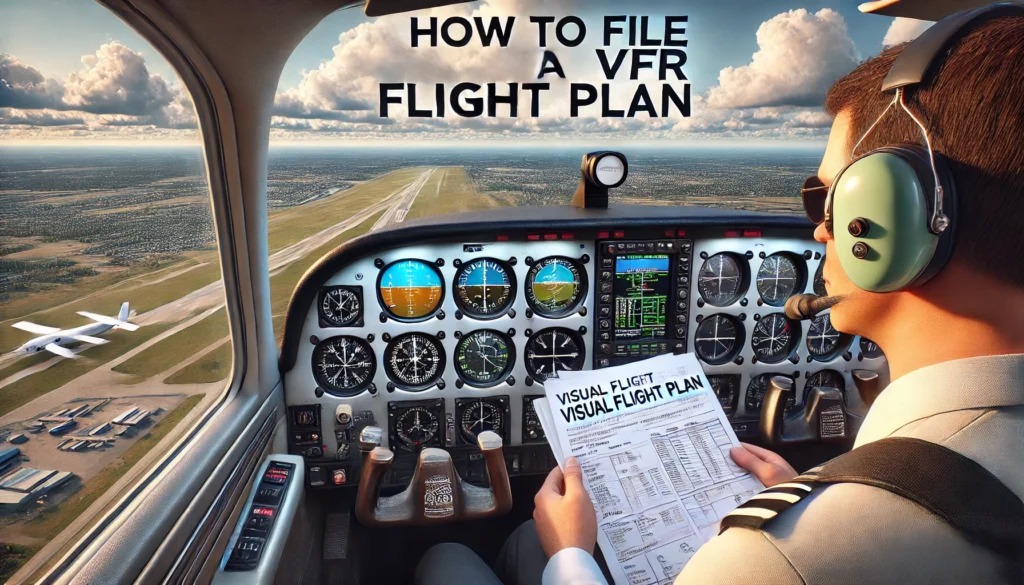Welcome to Wings Over Clouds! Today, I’ll guide you through “How to File a VFR Flight Plan”, the detailed process of filing a VFR flight plan. Filing a Visual Flight Rules (VFR) flight plan is essential for safe and efficient flying. Let’s break down the process into simple, manageable steps.
Understanding VFR Flight Plans
A VFR flight plan is a document filed with a flight service station. It provides important information about your flight to air traffic controllers and search and rescue teams. This plan ensures that someone knows your route, and can initiate a search if you don’t reach your destination.
Why File a VFR Flight Plan?
Filing a VFR flight plan isn’t mandatory but is a smart safety practice. It provides several benefits:
- Ensures someone knows your flight route and expected arrival time.
- Helps search and rescue teams locate you if necessary.
- Provides peace of mind for pilots and passengers.
Steps to File a VFR Flight Plan

1. Gather Required Information
Before filing your VFR flight plan, gather all necessary information. This includes:
- Departure and destination airports
- Route of flight
- Estimated time en route
- Fuel on board
- Number of people on board
- Aircraft type and registration
- The pilot’s name and contact information
2. Pre-Flight Weather Briefing
A thorough weather briefing is crucial for safe flying. Check for:
- Current weather conditions at departure and destination points
- Forecasted weather along your route
- Winds aloft and potential turbulence
- Notice to Airmen (NOTAMs) and Temporary Flight Restrictions (TFRs)
3. Use Flight Planning Tools
Utilize flight planning tools and apps like ForeFlight, SkyVector, or AOPA Flight Planner. These tools help you plot your course, estimate fuel consumption, and identify potential hazards. They also offer easy ways to file your flight plan electronically.
4. Complete the FAA Flight Plan Form
The FAA flight plan form, also known as FAA Form 7233-1, is the standard format for filing a VFR flight plan. Here’s how to complete each section:
- Aircraft Identification: Enter your aircraft’s registration number.
- Aircraft Type: Specify the make and model of your aircraft.
- True Airspeed: Enter your planned cruising speed.
- Departure Point: Specify your departure airport.
- Departure Time: Enter the proposed departure time in UTC.
- Cruising Altitude: Indicate your planned cruising altitude.
- Route of Flight: Describe your planned route.
- Destination: Enter your destination airport.
- Estimated Time En Route: Calculate the total flight time.
- Remarks: Include any additional information, such as alternate airports.
- Fuel on Board: State the total fuel available in hours and minutes.
- Alternate Airports: List alternate airports if your destination is unavailable.
- Pilot’s Information: Enter your name, address, and contact information.
- Number of People on Board: State the number of passengers and crew.
5. Filing Your Flight Plan
You can file your VFR flight plan by phone, online, or through flight planning apps. Here’s how:
By Phone
Call the nearest Flight Service Station (FSS) at 1-800-WX-BRIEF (1-800-992-7433). Provide the FSS specialist with your completed flight plan information. They will review and file it for you.
Online
Use the FAA’s online filing system or websites like 1800wxbrief.com. These platforms offer user-friendly interfaces for submitting your flight plan.
Flight Planning Apps
Apps like ForeFlight, Garmin Pilot, and FltPlan.com allow you to file your VFR flight plan directly from your device. They also provide real-time weather updates and other useful features.
6. Activate Your Flight Plan
Activating your flight plan is crucial. It ensures that search and rescue operations will commence if you do not arrive as planned. To activate your VFR flight plan:
- Contact FSS or air traffic control after takeoff.
- Provide your flight plan number and request activation.
7. In-Flight Monitoring
While flying, monitor your progress. Keep track of your position, fuel status, and weather conditions. Stay in contact with air traffic control if needed.
8. Closing Your Flight Plan
Upon reaching your destination, close your VFR flight plan. This step confirms that you have arrived safely. To close your flight plan:
- Contact FSS or air traffic control upon landing.
- Provide your flight plan number and confirm your arrival.
Tips for Filing a VFR Flight Plan

Plan Ahead
Thorough planning is key to a successful flight. Start your preparations well in advance. Ensure you have all the necessary information and tools at hand.
Stay Informed
Keep up-to-date with weather conditions, NOTAMs, and any changes to your route. Regularly check reliable sources for the latest information.
Use Technology
Modern technology offers numerous tools to simplify flight planning. Use apps and online platforms to enhance your planning and filing process.
Practice Makes Perfect
Filing a VFR flight plan can seem daunting at first. Practice regularly to become proficient. Familiarity with the process will boost your confidence and ensure smooth operations.
Keep Communication Open
Maintain regular communication with FSS and air traffic control. They provide valuable assistance and ensure your safety throughout the flight.
Safety First
Always prioritize safety. If conditions change or you encounter unexpected issues, don’t hesitate to alter your plans. Safety should always come first.
How to File a VFR Flight Plan “Final Thoughts”

Filing a VFR flight plan is a critical step for any pilot. It enhances safety, provides peace of mind, and ensures that help is available if needed. By following these steps, you can file your VFR flight plan efficiently and effectively. Remember, thorough preparation and regular practice are key to mastering this essential skill.
Explore more articles and tips on flight planning at Wings Over Clouds. Moreover, also do check out our latest product range, Happy Flying!

